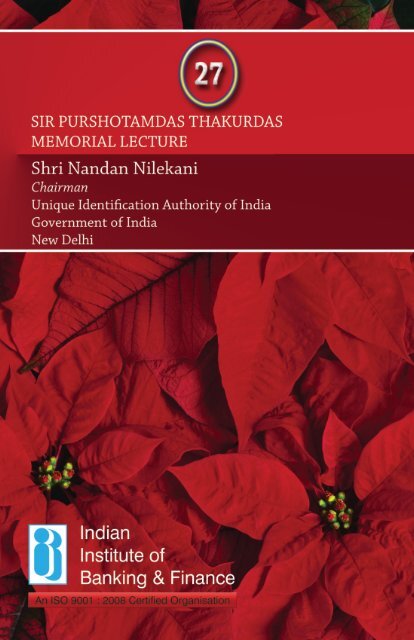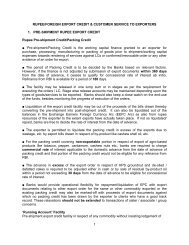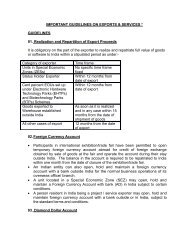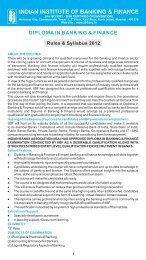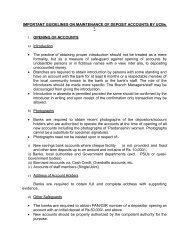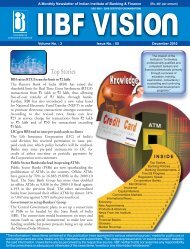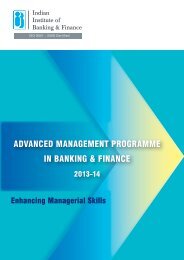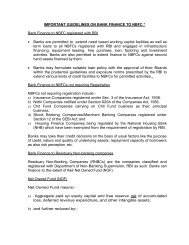Indian Institute of Banking and Finance 2
PTML Lecture Book - Cover - Indian Institute of Banking & Finance
PTML Lecture Book - Cover - Indian Institute of Banking & Finance
- No tags were found...
Create successful ePaper yourself
Turn your PDF publications into a flip-book with our unique Google optimized e-Paper software.
<strong>Indian</strong> <strong>Institute</strong> <strong>of</strong> <strong>Banking</strong> <strong>and</strong> <strong>Finance</strong>2
The Goal <strong>of</strong> Financial Inclusion -- Have We Reached The Tipping Point?About Sir Purshotamdas ThakurdasSir Purshotamdas Thakurdas or Sir P. T. as he was popularlyknown was a very distinguished <strong>and</strong> eminent businessman<strong>of</strong> India who took a keen <strong>and</strong> active interest in the economiclife <strong>of</strong> the country before <strong>and</strong> after independence.Sir P. T. was indeed, a severe critic <strong>of</strong> the policies followedby the British Government but his views, though dissenting<strong>and</strong> differing from the Government's policies, were greatlyappreciated <strong>and</strong> even valued by the then British Governmentas he was very constructive in his approach to the problems.Sir P. T. was associated with several committees <strong>and</strong>commissions appointed by the Government <strong>of</strong> India.Sir P. T. was a firm believer in the logic <strong>and</strong> philosophy <strong>of</strong>free enterprise <strong>and</strong> believed in the free forces <strong>of</strong> marketmechanism to bring about the rational allocation <strong>of</strong> scarceresources in the economy to promote growth <strong>and</strong>development. However, he was not dogmatic about thevirtues <strong>of</strong> free enterprise or market mechanisms. He hadaccepted the inevitability <strong>of</strong> State intervention at a certainstage <strong>of</strong> development in the country, as a necessary policyinstrument to promote growth keeping in view the imbalancesin the nature <strong>of</strong> the under developed economy. This has beenreflected in the famous book “Bombay Plan” published asearly as in 1944. This remarkable document was drawn upby a group <strong>of</strong> distinguished persons belonging to the privatesector <strong>and</strong> this document took a much broader view <strong>of</strong>the development process than one would expect from thepersons having faith in the market economy. The documentclearly stated that “no development <strong>of</strong> the kind we have3
<strong>Indian</strong> <strong>Institute</strong> <strong>of</strong> <strong>Banking</strong> <strong>and</strong> <strong>Finance</strong>proposed will be possible except on the basis <strong>of</strong> acentral directing authority which enjoys sufficientpopular support <strong>and</strong> possesses requisite powers <strong>and</strong>jurisdiction”. This reflected the farsightedness <strong>of</strong> theauthors <strong>of</strong> the Bombay Plan.Sir P. T. was closely associated with the <strong>Indian</strong> <strong>Banking</strong>Industry having worked as a member on the Board <strong>of</strong>Directors <strong>of</strong> the then Imperial Bank <strong>of</strong> India <strong>and</strong> also onthe Central Board <strong>of</strong> the Reserve Bank <strong>of</strong> India since itsinception in 1935.Sir P. T. was a very powerful <strong>and</strong> influential member onthe Board <strong>of</strong> the Reserve Bank <strong>of</strong> India. He was a prominentmember <strong>of</strong> the Central <strong>Banking</strong> Enquiry Committee <strong>and</strong>Chairman <strong>of</strong> the Rural <strong>Banking</strong> Enquiry Committee.In the formative years <strong>of</strong> the Reserve Bank <strong>of</strong> IndiaSir P. T. played an outst<strong>and</strong>ing role <strong>and</strong> he was consideredto be “both a driving force <strong>and</strong> a restraining influence”during the deliberations in the Board Room <strong>of</strong> the ReserveBank <strong>of</strong> India more particularly in matters pertaining tothe rights <strong>of</strong> the Reserve Bank <strong>of</strong> India <strong>and</strong> its autonomousfunctioning vis-à-vis the Government.Sir P. T. was greatly interested in the problems <strong>of</strong>money, banking, finance <strong>and</strong> exchange rates. Sir P. T.was associated with the <strong>Indian</strong> <strong>Institute</strong> <strong>of</strong> <strong>Banking</strong> &<strong>Finance</strong> (Formerly <strong>Indian</strong> <strong>Institute</strong> <strong>of</strong> Bankers) as its foundingmember <strong>and</strong> served on the Council <strong>of</strong> the <strong>Institute</strong> till histhdeath on 4 July 1961.4
<strong>Indian</strong> <strong>Institute</strong> <strong>of</strong> <strong>Banking</strong> <strong>and</strong> <strong>Finance</strong>th27 Sir Purshotamdas ThakurdasMemorial LectureThe Goal <strong>of</strong> Financial Inclusion --Have We Reached The Tipping Point?Shri N<strong>and</strong>an NilekaniChairmanUnique Identification Authority <strong>of</strong> IndiaGovernment <strong>of</strong> IndiaNew DelhiSBI Auditorium, Mumbaith9 December, 20102
<strong>Indian</strong> <strong>Institute</strong> <strong>of</strong> <strong>Banking</strong> <strong>and</strong> <strong>Finance</strong>2
The Goal <strong>of</strong> Financial Inclusion -- Have We Reached The Tipping Point?The Goal <strong>of</strong> Financial Inclusion --Have We Reached The Tipping Point?7N<strong>and</strong>an NilekaniIt's quite an honour to be here. I thank the organizersfor the opportunity to speak in the memory <strong>of</strong> SirPurushotamdas Thakurdas, someone who was among theleading lights <strong>of</strong> <strong>Indian</strong> industry, <strong>and</strong> also played anenormously influential role in the rise <strong>of</strong> our financialinstitutions.Financial inclusion has recently become something <strong>of</strong>a buzzword, publicized as an explicit goal for governmentsas well as for our major banks. Nevertheless, this is nota new objective. Providing broad-based financial servicesin India has been a clear part <strong>of</strong> our m<strong>and</strong>ate sinceindependence, <strong>and</strong> the government has since graduallychipped away at the barriers that have constrained accessto banking for the ordinary individual, the poor <strong>and</strong> themarginalized.There is nevertheless, a real difference between the financialinclusion efforts <strong>of</strong> the past <strong>and</strong> what is happening now.Till date, the growth <strong>of</strong> financial services was largely drivenby a push from the government <strong>and</strong> by banks. Banksresponded to expansionary m<strong>and</strong>ates to establish branchesacross rural India, <strong>and</strong> provide financial services even inhard to reach parts <strong>of</strong> the country. Today however, we arealso witnessing an unprecedented burst <strong>of</strong> dem<strong>and</strong> for1. See Kaminsky <strong>and</strong> Reinhart (1999).
<strong>Indian</strong> <strong>Institute</strong> <strong>of</strong> <strong>Banking</strong> <strong>and</strong> <strong>Finance</strong>financial services. As economic growth has taken <strong>of</strong>f, thedem<strong>and</strong> for a bank account has become much more pervasiveacross India's income groups <strong>and</strong> communities.As dem<strong>and</strong> has surged, we are witnessing innovationswithin the market <strong>and</strong> in government policy, that bringsus to a tipping point. I believe the resulting transition inthe next five years will permanently change the scale, <strong>and</strong>the shape <strong>of</strong> financial services in India.Early yearsMy friend <strong>and</strong> marketing consultant Rama Bijapurkar<strong>of</strong>ten points out that we <strong>Indian</strong>s are a very money-mindedpeople – 'Lakshmi, the goddess <strong>of</strong> wealth, ranks high onour pantheon <strong>of</strong> gods,' she notes, 'We revere her in festivalsacross the country.' The transaction <strong>of</strong> money – the depositing<strong>of</strong> it, the lending <strong>of</strong> it, <strong>and</strong> so on through indigenousbanks, was familiar throughout India well before the British.In the Laws <strong>of</strong> Manu, 'lending money' was considered one<strong>of</strong> only four 'honest callings.' This was culturally very differentfrom say medieval Europe, where the church forbade lendingmoney on interest. While in Europe <strong>of</strong> the time people wholent money were regarded as disreputable Shylocks, in Indiathe indigenous bankers <strong>and</strong> lenders – such as Manohardas,Gulabrai <strong>and</strong> the Jagat Seths – were highly respected.The arrival <strong>of</strong> the British however warped many institutionalsystems in India, <strong>and</strong> banking was no exception. Just asroad-building <strong>and</strong> rail became largely dedicated to enablingimperial trade <strong>and</strong> the movement <strong>of</strong> goods to India's portcities, banks prioritised trading <strong>and</strong> business transactions,8
The Goal <strong>of</strong> Financial Inclusion -- Have We Reached The Tipping Point?<strong>and</strong> were concentrated in urban areas. From the establishment<strong>of</strong> the first banks – the Bank <strong>of</strong> Hindustan <strong>and</strong> the BengalBank – the differences were clear.This urban, commercial tilt remained true <strong>of</strong> India's bankswell after independence. <strong>Banking</strong> services availed by thecommon people were primarily informal sources such aschit funds <strong>and</strong> moneylenders. The lack <strong>of</strong> easy financialaccess meant the absence <strong>of</strong> a 'banking habit' among ordinarypeople, which was obvious in how our parents' generationsaved money <strong>and</strong> accumulated assets – they stored wealthnot as money in bank accounts, but as gold jewellery <strong>and</strong>cash in locked armoires.Three nationalizationsThe state has battled this imbalance in financial accessover the last five decades. Post-independence, the statenationalized the Imperial Bank <strong>of</strong> India in 1955 to formthe State Bank <strong>of</strong> India, with the hope that the state'sm<strong>and</strong>ate <strong>of</strong> universal access would lend banking a moreinclusive focus.In July 1969, then Prime Minister Indira G<strong>and</strong>hi madebank nationalization an important part <strong>of</strong> her strategy tobuild broad appeal, <strong>and</strong> exp<strong>and</strong> key services to the poor.14 banks were nationalized. And in April 1980, Indiaunderwent another wave <strong>of</strong> nationalization, bringingmore than 90% <strong>of</strong> India's banking activity into the publicsector.The RBI has called the 1969 bank nationalization 'thedefining economic event <strong>of</strong> not just the 1960s but <strong>of</strong> the9
<strong>Indian</strong> <strong>Institute</strong> <strong>of</strong> <strong>Banking</strong> <strong>and</strong> <strong>Finance</strong>next few decades.' I wouldn't disagree. The rise <strong>of</strong>the public sector banks, <strong>and</strong> the 1:4 expansion policywhich m<strong>and</strong>ated four branches in unbanked areas forevery new urban bank branch completely transformedIndia's financial l<strong>and</strong>scape. Over 50,000 new bank brancheswere opened across India in the ensuing three <strong>and</strong> ahalf decades, bringing institutional banking to millions <strong>of</strong>ordinary people.Changing attitudesIndia's policy efforts have <strong>of</strong>ten been criticised as overlyslow <strong>and</strong> cautious. But this approach has had its advantages.India was able to build the institutions that eventually allowedmarket growth to take <strong>of</strong>f without substantial crisis.In banking in particular, this caution has had someadmirable results. Bank nationalization, <strong>and</strong> the effortsto spread banking services created an expansive bankinginfrastructure, which made substantial inroads into ruralIndia. The banking reforms that finally took place builton the foundations <strong>of</strong> these previous efforts. the state-ledpolicies also had a long-term impact on our attitudetowards the role <strong>of</strong> banks : we embraced the idea thatbanking must incorporate inclusion as part <strong>of</strong> its corem<strong>and</strong>ate, <strong>and</strong> that banking services should be easily availableto the poor.The era <strong>of</strong> deregulationThe eventual 1993 RBI guidelines encouraged the rise <strong>of</strong>young, private banks, as well as a new focus on 'moderninfrastructure'. With these banks, we saw the emergence <strong>of</strong>10
The Goal <strong>of</strong> Financial Inclusion -- Have We Reached The Tipping Point?an agile <strong>and</strong> IT-enabled approach to banking : where banksfunctioned as automated, networked entities.The rise <strong>of</strong> competition also encouraged new private playersas well as older public sector banks to experiment withremote service delivery, the use <strong>of</strong> smart cards <strong>and</strong> otherefforts to reach customers in the most efficient wayspossible. In addition, technological advances such as corebanking, the use <strong>of</strong> ATMs <strong>and</strong> telecom connectivity broughtconvenience for bank customers, with anytime, anywherefinancial access.Considering the progress <strong>and</strong> the many innovations weare now witnessing, the continued lack <strong>of</strong> penetration <strong>of</strong>bank services especially in rural India, seems baffling. Fully40% <strong>of</strong> rural <strong>Indian</strong>s lack bank accounts – a number thatrises among marginalized communities. This exclusion isdebilitating for the poor, whose small, volatile incomesmakes financial access all the more important for savings,<strong>and</strong> to insure themselves against crisis.In the last decade, we have seen access to basic servicesbecome a priority in government policies. Since the 1999telecom policy opened up the sector, the penetration <strong>of</strong>mobile phones in India exploded, from less than five millionconnections in 1997 to over 700 million today. But wehave yet to see comparable growth in the similarly essentialservice <strong>of</strong> banking.'Can we reach finance to people in a meaningful way?'A visit to an <strong>Indian</strong> village indicates a fundamental challengewe face in exp<strong>and</strong>ing banking services – the disconnect11
<strong>Indian</strong> <strong>Institute</strong> <strong>of</strong> <strong>Banking</strong> <strong>and</strong> <strong>Finance</strong>that exists between current bank models <strong>and</strong> the needs<strong>of</strong> the ordinary, rural <strong>Indian</strong>. Our Aadhaar team, on ruralvisits, found that many <strong>Indian</strong>s viewed banking as an alien,difficult experience. Even when they had accounts, theyrarely used them. The bank was usually far away, requiringtravel in a bus <strong>and</strong> the foregoing <strong>of</strong> a day's income ifthe person was a daily wage earner. There was little theperson could do if they needed money immediately, in case<strong>of</strong> a financial emergency.And once there, the bank required the <strong>of</strong>ten illiteratecustomer to fill a bewildering number <strong>of</strong> forms, <strong>and</strong> alsorequired documentation that the person did not have.Clearly a banking model which has been tailored forthe educated <strong>and</strong> urban population is now trying tocater to the needs <strong>of</strong> our vast rural country. In thissetting, it quickly reveals its weaknesses. The average bankdeposit in rural India is one-tenth that <strong>of</strong> urban India.When catering to the poor individual, the bank facesa customer who prefers to make numerous, very smalltransactions, which vastly increases costs for the bank,with little additional benefit in deposit value. The resultis that banks don't treat poor, rural market as a priority –every additional customer becomes a source <strong>of</strong> additionalexpense rather than pr<strong>of</strong>it.Reworking our approachesD. Subbarao, the RBI governor, has pointed out the needfor us to build additional bridges between the ordinary villager<strong>and</strong> the banks as they now exist. There have some interesting12
The Goal <strong>of</strong> Financial Inclusion -- Have We Reached The Tipping Point?experiments in this direction to make banking services moreaccessible to the poor, through business correspondentslocated within the village, <strong>and</strong> by enabling people to makeremote transactions.The objective <strong>of</strong> these steps is to shift our banking approachfrom a low-volume, high-cost model, to a high volume,low cost model, where large numbers <strong>of</strong> small transactionsbecome pr<strong>of</strong>itable to banks, mirroring the pattern <strong>of</strong> growth intelecom. However, this goal remains strait jacketed by basicweaknesses. Fulfilling Know Your Customer norms remain ahard-to-surmount challenge for banks. Many <strong>of</strong> the poor lackthe basic documentation they need to open a bank account,including a pro<strong>of</strong> <strong>of</strong> identity <strong>and</strong> pro<strong>of</strong> <strong>of</strong> address.The lack <strong>of</strong> easily verifiable identity also limits the online<strong>and</strong> mobile banking services that can be delivered to thepoor. Banks have tried to address this through remoteauthentication devices employed by village-based agents<strong>and</strong> BCs, who use smart cards to remotely verify theircustomers before allowing transactions. These verificationsystems however have remained proprietary to particularbanks, limiting large-scale expansion. If such an approachexisted in telecom, it would have been akin to allowing phonecalls only say, between BSNL subscribers!The pieces <strong>of</strong> financial inclusion are now in placeMuch <strong>of</strong> what is necessary to enable financial inclusionin India is already in place, with technological advancescoming powerfully together with policy efforts. The RBI forexample, recently exp<strong>and</strong>ed the definition <strong>of</strong> the business13
<strong>Indian</strong> <strong>Institute</strong> <strong>of</strong> <strong>Banking</strong> <strong>and</strong> <strong>Finance</strong>correspondents who can serve as the final link between thevillagers <strong>and</strong> a bank. Now, self-help groups, kirana stores,post-<strong>of</strong>fices as well as for-pr<strong>of</strong>it entities can function asBCs, creating the potential for a denser <strong>and</strong> more accessiblebank network. The spread <strong>of</strong> core banking systems meansthe technology for anywhere banking is in place. The no-frillsbank account, with limited KYC norms <strong>and</strong> which allows azero balance has become a widely accepted service solutionfor the poor.In addition, the large, exp<strong>and</strong>ing base <strong>of</strong> mobile phoneconnections has put in place the infrastructure necessaryfor delivering financial services remotely <strong>and</strong> through BCsto the poor. There are also multiple mobile end-devicesnow in use by banks that can verify bank customersthrough smart-cards or fingerprinting. And finally with theNPCI, we have since 2008 what is an umbrella paymentauthority.Urgency in enabling accessThe infrastructure for financial inclusion has come <strong>of</strong> ageat the right time. India's growth has come with a radicaltransformation in what people aspire to achieve acrossincome groups <strong>and</strong> communities. Previous generationshad little opportunity to change the circumstances theywere born into, as access to education <strong>and</strong> jobs was difficult.But in the last two decades, economic <strong>and</strong> social mobilityhas become a real possibility in India, <strong>and</strong> hundreds aremoving across the country, to our cities <strong>and</strong> towns everyday in search <strong>of</strong> opportunities – for city lights <strong>and</strong> fightingchances.14
The Goal <strong>of</strong> Financial Inclusion -- Have We Reached The Tipping Point?These changes mean that filling in the missing pieces thatlimit access to services such as finance is even more urgent.This is where the unique identity number comes in.Connecting the dots : the unique identity numberThe power <strong>of</strong> the number stems from how it serves asa universal identity infrastructure. The Aadhaar numbersubstantially reduces the risks inherent within the BCnetwork – it enables the bank to easily <strong>and</strong> instantly verifyan individual's identity, directly or through the BC usingthe Aadhaar number, before they open an account, or priorto a transaction. The person can verify their identity througha number <strong>of</strong> means – through biometrics for maximumsecurity, as well as through their demographic information,or using a PIN number.Such verification can take place anywhere in India <strong>and</strong>through any device since the Aadhaar number <strong>and</strong> individualdetails are stored in a central database. The mobility it<strong>of</strong>fers is unsurpassed, <strong>and</strong> it gives the poor same financialportability urban India has long had with ATMs <strong>and</strong> corebanking services.In addition, Aadhaar number verification opens up thepossibility <strong>of</strong> self-service in banking transactions througha mobile phone. We can realistically consider a near-cashlesseconomy in our villages, where individuals electronicallytransfer money to bank accounts with the help <strong>of</strong> mobilephones <strong>and</strong> BCs.The open architecture the Aadhaar number <strong>of</strong>fers –enabling transactions through any device, any BC, anywhere15
<strong>Indian</strong> <strong>Institute</strong> <strong>of</strong> <strong>Banking</strong> <strong>and</strong> <strong>Finance</strong>in the country – brings down the remaining barriers towardsbuilding highly scalable financial services for the poor.The number thus serves as the glue that ties our variousefforts in financial inclusion together. It enables afinancial inclusion strategy that is low-cost, easily scaled,<strong>and</strong> adapted to the behaviour <strong>of</strong> the poor. It enablesbanks to earn transaction fees on remote <strong>and</strong> BC-enabledtransactions, making high-volume micro-transactionsviable. It helps even the poorest to build a credit history,lowering the risk for banks in this market. And it givesmillions more the opportunity to save, make investments,<strong>and</strong> use products such as micro-insurance.Building towards growthA significant difference between the efforts in financialinclusion today <strong>and</strong> what came before, is that now there isnot just a growing supply <strong>of</strong> financial services, but alsoimmense dem<strong>and</strong> for it. Over the last decade, policy shiftsas well as market trends have created widespread awareness<strong>of</strong> how valuable a bank account can be.A new generation <strong>of</strong> welfare initiatives such as the NREGA<strong>and</strong> the JSY are <strong>of</strong>fering the poor cash benefits <strong>and</strong>incentives, which are paid to them through bank accounts<strong>and</strong> post <strong>of</strong>fice savings accounts. Another factor drivingdem<strong>and</strong> for bank accounts is the millions <strong>of</strong> people whohave left villages <strong>and</strong> now remit money back home.Un<strong>of</strong>ficial estimates put the cash travelling throughinformal remittance corridors, from towns to rural hutments,at thous<strong>and</strong>s <strong>of</strong> crores.16
The Goal <strong>of</strong> Financial Inclusion -- Have We Reached The Tipping Point?Changes in the local rural economy have also increasedthe cash circulating within villages, <strong>and</strong> the consequentdem<strong>and</strong> for bank accounts. Many agricultural labourerswho were once paid in kind for their work – in the form<strong>of</strong> food <strong>and</strong> clothes – are now paid in daily wages.Perhaps nothing exemplifies the change in attitudetowards investments <strong>and</strong> savings in rural India betterthan the change in status for the buffalo. Across northIndia in particular, the buffalo has been a prized asset,<strong>and</strong> the rich indicated their status through the number<strong>of</strong> the animals they owned. In recent years however, theregard for the buffalo has fallen – it is increasingly seenas an expensive investment, one with low returns, illiquidcompared to money <strong>and</strong> houses, <strong>and</strong> difficult to sell whenan immediate need arises.The untapped potentialIndia's financial depth today is substantially lower thanother Asian countries including Thail<strong>and</strong>, Korea, China<strong>and</strong> Malaysia. I believe that a pro-poor approach towardsfinancial inclusion will consequently trigger a growthcurve similar to what we witnessed in the telecom sector.The Aadhaar number would bring to our financialinclusion approach the same features that drove rapidtelecom expansion – geographical mobility in services,the dominance <strong>of</strong> low-cost, high volume micro-transactions,negligible upfront costs, <strong>and</strong> a dense, easily accessiblenetwork <strong>of</strong> agents retailing the service.17
<strong>Indian</strong> <strong>Institute</strong> <strong>of</strong> <strong>Banking</strong> <strong>and</strong> <strong>Finance</strong>Within the UIDAI, we are already seeing massive dem<strong>and</strong>for bank accounts among people enrolling for Aadhaarnumbers – fully 80% <strong>of</strong> people enrolling for the numberwant bank accounts. If we are able to provide every suchperson with a bank account, financial access will simplyexplode in India. Considering the pace <strong>of</strong> enrolments forthe Aadhaar number, it is a very real possibility that thenumber <strong>of</strong> bank accounts we issue in the next four yearswill exceed the number <strong>of</strong> accounts banks have issued sinceIndia's independence.The great transformationIn the last decade, we have witnessed a decisive breakingaway from what economists used to call the 'culture <strong>of</strong>poverty' in India – the beaten-down, no-way-out circumstances<strong>of</strong> India's marginalized <strong>and</strong> its poor.While we still have hundreds <strong>of</strong> millions in poverty,their environment <strong>and</strong> the tools available to them arechanging fast. We are building services <strong>and</strong> products tocater to the poor – accessible consumer goods, decentralizedgovernance infrastructure, low-cost solutions in lighting,water supply, transportation, <strong>and</strong> so on. At the same timeexp<strong>and</strong>ed information services as well as telecom <strong>and</strong>financial access are connecting the poor more closely toour markets.They say fortune is all about timing, <strong>and</strong> India hasbeen incredibly fortunate that our growth is happeningat a time when we have the technological tools totransform service access – in welfare, telecom, <strong>and</strong>18
The Goal <strong>of</strong> Financial Inclusion -- Have We Reached The Tipping Point?increasingly, finance. We now have the chance to buildservices that are efficient <strong>and</strong> truly innovative – 'made inIndia' solutions. Our success in building these solutionswill enable us to not just meet the expectations for India'sgrowth, but substantially surpass them.19
<strong>Indian</strong> <strong>Institute</strong> <strong>of</strong> <strong>Banking</strong> <strong>and</strong> <strong>Finance</strong>About the SpeakerShri N<strong>and</strong>an Nilekani is the Chairman <strong>of</strong> theUnique Identification Authority <strong>of</strong> India (UIDAI)in the rank <strong>of</strong> Union Cabinet Minister, which aimsto provide a unique identification number for allresidents <strong>of</strong> India.Shri N<strong>and</strong>an Nilekani was most recently theCo-Chairman <strong>of</strong> the Board <strong>of</strong> Directors <strong>of</strong>Infosys Technologies Limited, which he c<strong>of</strong>oundedin 1981. He was serving as Directoron the Company's Board since its inceptionto July 2009. He has held various posts atInfosys, including Chief Executive Officer<strong>and</strong> Managing Director, President, <strong>and</strong> ChiefOperating Officer.Shri N<strong>and</strong>an Nilekani co-founded India'sNational Association <strong>of</strong> S<strong>of</strong>tware <strong>and</strong> ServiceCompanies (NASSCOM) as well as theBengaluru chapter <strong>of</strong> the IndUS Entrepreneurs(TiE). He is a member <strong>of</strong> the Board <strong>of</strong>Governors <strong>of</strong> the <strong>Indian</strong> Council for Researchon International Economic Relations (ICRIER)<strong>and</strong> the President <strong>of</strong> NCAER (the premier,independent, applied economics research<strong>Institute</strong> in India).Born in Bengaluru, Shri N<strong>and</strong>an Nilekanireceived his Bachelor's Degree in ElectricalEngineering from the <strong>Indian</strong> <strong>Institute</strong> <strong>of</strong>Technology, Bombay. He was named theCorporate Citizen <strong>of</strong> the Year at the Asia20
The Goal <strong>of</strong> Financial Inclusion -- Have We Reached The Tipping Point?Business Leaders Award (2004) organized byCNBC. In 2005, he received the prestigiousJoseph Schumpeter Prize for innovative servicesin economy, economic sciences <strong>and</strong> politics.In 2006, he was awarded one <strong>of</strong> India'shighest civilian honours, the Padma Bhushan<strong>and</strong> was also named Businessman <strong>of</strong> the Yearby Forbes Asia. Time magazine listed him asone <strong>of</strong> the 100 most influential people in theworld in 2006 <strong>and</strong> 2009. He is the author <strong>of</strong>'Imagining India', which was one <strong>of</strong> the finalistsfor the FT-Goldman Sachs Book Award for theyear 2009.21
<strong>Indian</strong> <strong>Institute</strong> <strong>of</strong> <strong>Banking</strong> <strong>and</strong> <strong>Finance</strong>Previous LecturesSr. Year Name <strong>of</strong> the Title <strong>of</strong> the lectureNo. speakers1. 1981 Shri L. K. Jha Supply-side Economics2. 1982 Shri K. N. Raj The Global Slump <strong>and</strong> ‘Rules <strong>of</strong>the Game’3. 1983 Mr. Dragoslav International Financial Co-operation :ArvamovicProblems <strong>and</strong> Prospects4. 1984 Shri Amiya Kumar The Economics <strong>of</strong> Business <strong>and</strong>BagchiBusiness <strong>of</strong> Economics5. 1985 Mr. Alex<strong>and</strong>re Structural Changes in InternationalLamfalussyFinancial Markets6. 1986 Shri Sukhamoy Report <strong>of</strong> the Committee to reviewChakravartythe working <strong>of</strong> the Monetary System& Re-examination7. 1987 Shri Jagdish <strong>Indian</strong> Economic Performance <strong>and</strong>BhagwatiPolicy Design8. 1988 Shri A. M. Khusro Management <strong>of</strong> <strong>Indian</strong> EconomyMacro-economic <strong>and</strong> Sectoral Policies9. 1989 Shri M. S. Gore India <strong>and</strong> the Concept <strong>of</strong> Nation State10. 1990 Shri A. Vaidyanathan Cottage <strong>and</strong> Small Industries inIndia-Policy <strong>and</strong> Performance11. 1991 Shri M. Narasimham Financial Sector Reforms12. 1993 Dr. I. G. Patel Some Reflections <strong>of</strong> FinancialLiberalisation13. 1994 Dr. Arjun Sengupta The Financial Sector <strong>and</strong> Reformsin India14. 1995 Dr. Shanker Acharya The Economic Consequences <strong>of</strong>Economic Reforms15. 1996 Dr. Parthasarathi Fiscal Policy in 1990s : NeededShomeReforms <strong>and</strong> Ramifications forthe Financial Sector22
The Goal <strong>of</strong> Financial Inclusion -- Have We Reached The Tipping Point?Previous LecturesSr. Year Name <strong>of</strong> the Title <strong>of</strong> the lectureNo. speakers16. 1998 Shri S. S. Tarapore Need for Second Generation<strong>Banking</strong> Sector Reforms17. 1999 Dr. R. A. Mashelkar Resurgence <strong>of</strong> Innovative India :The Challenges <strong>and</strong> Strategy18. 2000 Dr. C. Rangarajan Capital Flows : Another Look19. 2001 Shri P. Chidambaram Economic Reforms - Reappraisingthe Past; Lessons for the Future20. 2003 Shri N. R. Narayana Reinventing <strong>Banking</strong> in IndiaMurthy21. 2004 Dr. Richard C. Levin Patents in Global Perspective22. 2005 Dr. Montek Singh Globalisation <strong>and</strong> India - ChallengesAhluwalia<strong>and</strong> Opportunities23. 2006 Dr. Guillermo Ortiz Growth <strong>and</strong> stability in LatinAmerica <strong>and</strong> Asia24. 2007 Tan Sri Dato’ Managing Financial liberalisationSri Dr. Zeti Akhtar <strong>and</strong> its Challenges : ImplicationsAzizfor Emerging Economies25. 2008 Dr. Ashok K. Lahiri <strong>Indian</strong> Financial Reforms :National Priorities amidstan International Crisis26. 2009 Dr. Vijay Kelkar On Strategies for Disinvestment<strong>and</strong> Privatisation23
NOTES
About the institute<strong>Indian</strong> <strong>Institute</strong> <strong>of</strong> <strong>Banking</strong> & <strong>Finance</strong> (IIBF), formerly The <strong>Indian</strong> <strong>Institute</strong> <strong>of</strong>Bankers, established in 1928 is a pr<strong>of</strong>essional body <strong>of</strong> banks, financial institutions<strong>and</strong> their employees in India. During its 82 years <strong>of</strong> service, IIBF has emergedas a premier institute in banking <strong>and</strong> finance education for those employedin the sector, aiming for pr<strong>of</strong>essional excellence. Since inception, the <strong>Institute</strong>has awarded over 5 Lac banking <strong>and</strong> finance qualifications, viz., JAIIB, CAIIB,Diplomas <strong>and</strong> Certificates in specialized areas. The pedagogy <strong>of</strong> Distance Learning<strong>of</strong>fered by the <strong>Institute</strong> comprises (I) publishing specific courseware for eachpaper / examination; (ii) publishing work books; (iii) holding tutorials throughaccredited institutions; (iv) organizing contact classes; (v) conducting virtualclasses; (vi) <strong>of</strong>fering e-learning through portal; (vii) organising campus trainingfor selected courses, etc. For details please visit : www.iibf.org.in.
<strong>Indian</strong> <strong>Institute</strong> <strong>of</strong> <strong>Banking</strong> & <strong>Finance</strong>'The Arcade' World Trade Centre, Cuffe Parade, Mumbai - 400 005.Tel. : 2218 7003 / 04 / 05 • Fax : 2218 5147 / 2215 5093E-mail : iibgen@bom5.vsnl.net.inVisit us at : www.iibf.org.inPrinted at Quality Printers (I) Tel. : 2492 2297


